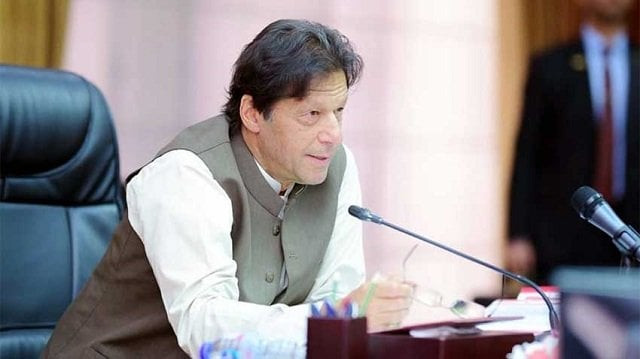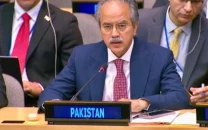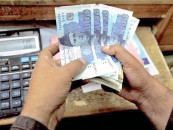Pakistan’s economy battling a host of challenges
Failure to boost tax collection, exports is pushing govt to continue to borrow

PHOTO : RADIO PAKISTAN
On the fiscal front, the main challenges are insufficient revenue generation and high fiscal deficit whereas on the external front, exports have an insignificant growth and there are fears of a slowdown in remittances.
The Pakistan Tehreek-e-Insaf (PTI) government is trying to overcome the fiscal challenge by implementing a set of World Bank-financed tax reforms. But unscrupulous elements in the bureaucracy continue to throw a spanner in the works.
The result is that tax revenue targets remain elusive. The government is borrowing heavily from banks by crowding out the private sector to fill in the fiscal gap.
Since the private sector is not getting enough bank financing, it is producing less. This low production is dragging down the GDP growth. State Bank of Pakistan (SBP) Governor Dr Reza Baqir fears growth can fall below 3.5% in the current fiscal year. The IMF has forecast an even lower growth of just 2.4%.
In first half (Jul-Dec) of the current fiscal year, the tax revenue collection fell short of the target by Rs290 billion and the fiscal deficit stood around Rs995 billion or 2.3% of GDP.
In seven months (Jul-Jan) of 2019-20, the Federal Board of Revenue (FBR) reported tax collection of Rs2.4 trillion. Can the tax machinery collect another Rs2.8 trillion in the next five months of the year to meet the recently revised full-year target of Rs5.2 trillion? Definitely, not.
The FBR has already informed the visiting IMF review mission that total tax collection in FY20 could reach Rs4.5 trillion. Even if the government, under the IMF pressure, introduces additional taxation measures and accelerates tax subsidy withdrawals, the total collection could hardly touch Rs4.7 trillion.
However, the IMF has agreed to relax the tax collection target from the original Rs5.5 trillion to Rs5.2 trillion – ignoring the FBR’s request to reset it at Rs4.5 trillion or Rs4.7 trillion.
Media reports quoting FBR officials suggest that the tax revenue shortfall during the entire FY20 could reach Rs750 billion. To fill this huge gap, the government will be forced to continue excessive borrowing from banks, further crowding out the private sector.
Besides, it will compel the government to make deeper cuts in development expenses. The lower credit offtake by the private sector coupled with slashed development spending will further constrain GDP growth, pushing it perhaps to the IMF’s projected level of 2.4%.
This becomes all the more likely scenario when we see no serious efforts to boost non-tax revenue collection by the government. Overall fiscal deficit will likely reach 7.2% of GDP in line with the IMF estimate.
This would be lower than the 8.9% deficit seen in FY19 but still quite high. Such is the gravity of the main fiscal challenge.
External front
The principal challenge on the external front – low export growth standing at 3.15% year-on-year in dollar value in the first half of FY20 – is no less grave.
Total merchandise export earnings grew to just $11.533 billion in 1HFY20 against $11.181 billion in 1HFY19.
So, at this stage there is little scope for encouraging imports of industrial raw material to lift the country’s large-scale manufacturing sector out of recession. This, in turn, means industrial growth may remain stalled in the near future.
The exchange rate stability has been achieved through borrowed foreign exchange, thus keeping the external debt servicing pressure intact and exports are not growing fast enough.
There is also no room for the rupee to become strong enough in the short term to create demand for the import of even consumer goods. This is restricting import-led consumption.
Consumption of domestically produced stuff is also dwindling because of falling income levels and high inflation. Inflation is stubbornly high and is on the rise.
In Jan 2020, the annualised consumer inflation shot up to 14.6% - double the pace of 5.6% in Jan 2019, according to the Pakistan Bureau of Statistics.
Agriculture is not growing at the desired pace and industries are producing less. The SBP has refused to relax its tight monetary policy for February-March, dashing hopes of Prime Minister Imran Khan and annoying the business leadership at large.
However, the central bank has expanded the interest rate subsidy regime for the exporters. The SBP believes it could not have done better under the present circumstances.
Inflation is so high that easing the monetary policy is out of question, more so because it continues to help attract foreign investment in government debt securities.
Insulating the exporters from the tight monetary policy had become necessary to reduce dependence on the hot money or investment in short-term government debt papers by foreign investors. In seven months of the current fiscal year, such investments reached a historic high of $2.9 billion.
Fallacy
The PTI government is hoping for the export-sector revival by incentivising the exporters but that is a fallacy. Unless it resolves the circular debt issue in the energy sector, which is behind the rapid upward revision in energy prices, exports cannot be increased substantially.
This seems more likely also because the global trade growth has hit a low of 1% and the global GDP growth has fallen to 2.9% against the 2009-2018 average of 3.5%, according to a recent IMF report.
Meanwhile, economic slowdown in the US and the UAE and repatriation of hundreds of thousands of Pakistanis working in Saudi Arabia also threaten to affect Pakistan’s remittances’ growth.
Failure to accelerate revenue collection and boost export earnings is pushing the government to continue to borrow from domestic as well as external resources. The resultant increase in the debt stock is pushing up the cost of both domestic and external debt servicing.
That, in turn, is creating fiscal deficit even in the midst of reduction in other expenses and is disallowing a significant revaluation of the rupee despite contraction in the current account deficit. Pakistan’s economy is seemingly trapped in a vicious cycle and no early exit is in sight.
The writer is a mechanical engineer and is doing masters
Published in The Express Tribune, February 10th, 2020.
Like Business on Facebook, follow @TribuneBiz on Twitter to stay informed and join in the conversation.



















COMMENTS
Comments are moderated and generally will be posted if they are on-topic and not abusive.
For more information, please see our Comments FAQ